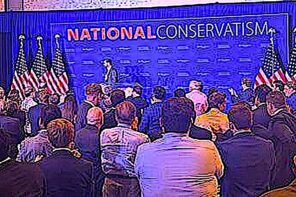When I showed up at New York’s Judson Church in 1994 at least some of the wonderful congregants there were puzzled that I put so much emphasis on economic justice. They had called an openly gay minister, and some thought I’d be spending more time in the LGBT rights space and less time trying to help out with the organizing of low-wage culinary workers, many of them toiling for less than a subsistence in the bowels of the big financial houses, making sandwiches for rich guys. My rants from the pulpit about the perils and problems of NAFTA and against Clinton’s support for further financial deregulation weren’t always welcomed. Some Judson folks dismissed this as just a residue left over from my years working in the labor movement; others thought I was seriously out of step with the tenor of the times. I had not made my peace with living in a New Gilded Age, and they had.
I make no claim to having been ahead of my time, and I loved every minute of my experience with that spirited and serious-minded faith community. But I was reminded of my outlier status back then when I read Ginia Bellafante’s piquant “Big City” interview with Kurt Andersen in Sunday’s Times. Andersen’s bestselling new book, Evil Geniuses, amounts to an extended mea culpa for his own inability, and the inability of culture liberals like him, to grasp what said geniuses were doing to remake the political economy from around 1970 onward, but especially during those crucial 1990s, the decade when leading Democrats joined with Republicans in abandoning the idea that there is any kind of social contract that matters.
As Andersen tells Bellafante, liberals like him played the role of “useful idiots” as the last century’s Great Divergence was gathering force, and as wealth wasn’t just trickling but surging upward, and as a federal government, thoroughly colonized by neoliberals, actively enabled the greedhead pirate crew to loot the fortunes of middle class and working people.
Over the course of 388 brisk pages, Andersen does much more than apologize for managing to ignore the defining feature of life in this country since 1970: the effective takeover of power at every level by corporate interests and the wealthiest. He applies his formidable explanatory and reportorial prowess to unpacking how conservative and corporatist apparatchiks exceeded their own wildest ambitions in completely undoing the premises and core principles of the New Deal and the postwar social compact. They accomplished this feat in just 30 years of concerted effort. Andersen shows us how they did it through sins of commission but also sins of omission: quietly declining to renew key regulatory provisions, dropping cost-of-living indexing for recipients of various public benefits, letting the real value of the federal minimum wage drop by 31% since 1968, etc. He doesn’t flinch from detailing how much damage was done with the enthusiastic blessing of liberal Democrats.
Many of us know bits and pieces of this story: the Powell Memorandum, the early investment in building up rightwing infrastrucure made by megarich types like Joe Coors, John Olin, Richard Mellon Scaife, Harry Bradley, Richard DeVos, and Chares & David Koch; the strategic seeding of various think tanks (Heritage, Cato, etc.), campus based “centers” and “institutes,” and even whole new campuses (George Mason U); the bankrolling of a reactionary media infrastructure; the strange bedfellows alliance of economic libertarians with conservative culture warriors for distraction purposes; and (needless to say) the revanchist Right’s takeover of most of the federal judiciary via their careful fostering of “law and economics” theory and their strategic development of the Federalist Society.
Andersen reminds us of the evil characters—almost all of them powerful white men—who strode the big stage in the achievement of this transformation. He takes us down memory lane with names like Weyrich and Wanniski, Feulner and Buchanan, Bork and Scalia, Friedman and Feldstein, Stockman and Greenspan, Norquist and Gingrich, Gilder and Laffer, Bartley and Murray, Kristol and Fukuyama, Icahn and Welch, Kravis and Milken, Murdoch and Ailes, Mercer and Limbaugh: a vast gallery of rogues, miscreants, and kooks, each of them dedicated to the long-term project of ensuring that wealth is never shared, that the rich grow richer still, and that the only real freedom that counts is the freedom to make and hoard money while ignoring the beggars at the gate.
As Andersen amply documents (and do consult Robert Reich’s latest if you think that Andersen overstates the case), these architects of our vampire capitalism, together with their political accomplices, reduced capital gains and inheritance taxes to historically low levels; they crushed unions and undermined labor law with gleeful relish, inventing the “independent contractor” subterfuge to thwart organizing and creating a whole new underclass of temp and on-demand workers; they made share price the all-important criterion for business success and legitimated stock buybacks in ways that greatly enhanced CEO pay and encouraged insider trading; they made a mockery of antitrust law; they contrived shady new financial instruments (CDOs, etc.) that enriched Wall Street manipulators while bankrupting millions of borrowers; they shipped two-thirds of our manufacturing jobs to Mexico and China and then stripped away the pension benefits of the workers who remained; they even managed to turn public schools and public prisons into profit centers for the investor class.
And these days: big-time private equity operators wringing billions from pain and suffering in disease-ridden nursing homes? Kids dying outright while the old and desperate lose their houses over the unregulated cost of insulin? Only in America, and only because we alone entrust our health and welfare to the tender mercies of private enterprise and the sharks who run it.
But the main thing the sharks did—and Andersen is very good at telling this part of the story—is to seize the common discourse, to convince a huge part of the “new class” who were then involved in journalism and politics, that all of the deregulating and union-busting and pension-stripping and privatizing and leveraging was somehow benign or even good for the country—good for freeing up capitalist “animal spirits” that magically create wealth for everyone, good for breaking the heavy-handed grip of a sclerotic nanny state.
Andersen mentions the parade of smart young journalists—all of them marquee names now—who drank this Kool Aid under the tutelage of the Washington Monthly’s Charlie Peters. The useful idiocy of this group was of course matched by the useful idiocy (or worse) of New Democrat pols like Gary Hart and Bill Clinton who recycled Republican ideas and repeated the classic libel that the poor deserve to be poor because of their personal moral deficiencies.
As long as affluent culture liberals could be assured that the rainbow flag was hoisted high enough and that Roe was still the law of the land and that the mediasphere was still broadly diverse, they felt they needn’t worry about emerging oligopolies in one economic sector after another. They needn’t worry about the flood-tide of mostly undisclosed corporate spending on electioneering and lobbying that quickly turns nearly all of our politicians into handmaidens for hypercapitalism.
Because he knows his cultural history so well, Andersen is at his best in noting how libertarianism broadly complements “originalism” in the law and how easy it is for people devoted to alternative rock to find the idea of “alternative investments” congenial. He marks the prevalence of nostalgia in popular entertainment as a kind of brain-softening anodyne applied at the very time that the real income and political power of the people blissfully consuming most of this stuff was being drastically undercut. He is acutely sensitive to how liberal pinheads like himself—and like me—who went to elite colleges can find it awkward to criticize arrangements that have made so many of our classmates so incredibly rich.
A raging pandemic and a concomitant economic collapse are only accelerating the extreme concentration of wealth and power that Andersen now finds alarming. Huge advances in the application of Artificial Intelligence will cast a large shadow over the future of most jobs even in a “healthy” economy. Climate change is bearing down fast. It’s growing more and more obvious that something has to give and that we need to create a very different political economy in order to avoid total strangulation and an even scarier politics—and more Boogaloo brownshirts in the streets—than we have now.
Given everything we know about most Americans’ continuing devotion to individualism and the “free enterprise” system, it’s safe to say that radical revolution isn’t in the cards anytime soon. But a bourgeois revolution, in which former useful idiots like Kurt Andersen turn their backs on winner-take-all capitalism and insist on a major power rebalancing? Some days I would almost be willing to settle for that. Educated white liberals are hardly the only constituency that matters in a multipolar political culture, and they always tend to get just enough crumbs from the tables of the truly rich to make their thoroughgoing conversion unlikely.
But nothing would please me more than to see many more people in this group begin to see the light. Nothing would give me more satisfaction than to see a much wider rejection of the highly doubtful idea that we can continue to live with a vicious class system, provided that the cast of players running that system is sufficiently diverse.
This last point takes me to the major weakness in Andersen’s book. Although he cites the murder of George Floyd and acknowledges a rising anti-racist movement, there’s no real reckoning with racism or with a white American Christianity that is thoroughly steeped in racism. His summary account of the old “lost America”—the Land of Opportunity and all that—ignores the huge cruelties and costs extracted by brutal slavery and white supremacy. Nor does Andersen address the “righteous mind” problem: how the lasting legacy of Puritanism tends to undergird deference toward the wealthy while fueling reaction against the ironic counterculture that Andersen himself helped to create as a co-founder of Spy magazine.
On race, I have a hunch that Andersen is afraid to engage the fraught “debate” that always gets reduced, simplistically, to a binary choice: Is it race, or is it class? As we would expect from a fired-up recent convert, Andersen wants to foreground the centrality of class. He should have given more attention to white supremacy and racism, without which the U.S. would not exhibit its uniquely savage inequality.
As Isabel Wilkerson makes clear in her new book Caste: The Origins of our Discontents, we are always dealing in this country with a toxic fusion of race and class oppression. That said, there’s never any getting around the blunt reality of social class, and I believe Andersen deserves credit for showing how an ever-more-powerful overclass has shaped the political economy we all inhabit.
If we’re lucky, we will move past the ever-more-sterile “debate” and get on with the business of uniting to overthrow an oppressive and highly racialized U.S. hypercapitalism. Because if we don’t—if we continue to spend energy in a pointless and embarrassing pissing contest—the Big Boys will just keep laughing at us, all the way to the bank.





